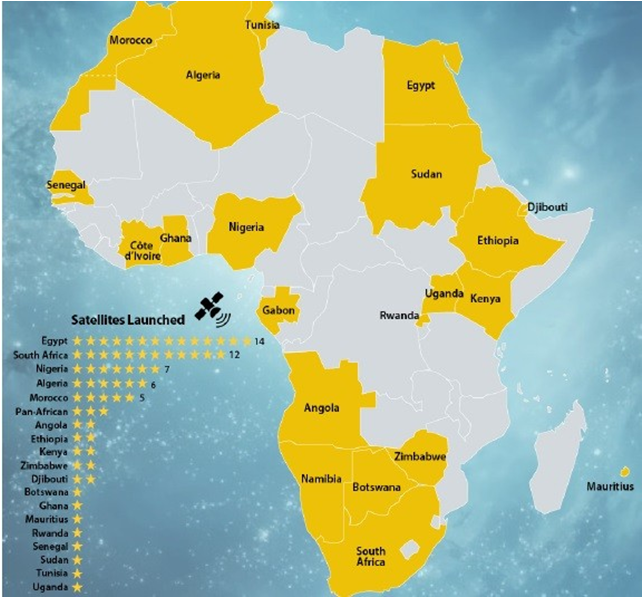African space programs are emerging as a significant driver of growth and innovation. However, balancing economic promises with budgetary constraints presents a delicate equation: transforming space exploration into tangible benefits for populations remains a challenge.
A Strategic Investments Fuel Growth
Satellites and space programs have increasingly become concrete tools for security, connectivity, and development across Africa in recent years. An African Center for Strategic Studies (ACSS) report, dated September 9, 2025, indicates that African states allocate around $500 million annually to their space initiatives. This figure appears substantial for a continent still grappling with poverty, education, and health challenges. Yet, these investments underpin major strategic imperatives: sovereignty, resilience, and a prominent position in the global digital economy. Egypt, South Africa, Nigeria, Morocco, Algeria, and Angola lead the continent’s space efforts, having made sustained investments in the sector. Their programs encompass Earth observation, communication, and scientific satellites, often supported by international partnerships. South Africa even collaborates with NASA on the Artemis program, focusing on lunar return and Mars exploration.
The continent currently has over 120 additional satellites in development, with launches scheduled by 2030. The ACSS states that over 21 African countries now operate space programs, and 18 have launched at least one satellite. Africa has collectively launched 65 satellites, including CubeSats.

Source: Space in Africa, ACFSS.
Technology Meets Daily Life
For many African governments, space represents a necessity, not a luxury. Satellites offer diverse applications: they enable border surveillance, combating terrorism, smuggling, and illegal fishing. They provide unprecedented visibility over vast, often inaccessible territories where ground patrols prove ineffective. At sea, satellites protect Africa’s exclusive economic zones, plundered for decades by foreign fleets. On land, they help track illegal mining and deforestation. Even wildlife protection benefits from satellite-geolocated collars, aiding anti-poaching efforts. In economies where agriculture often employs the majority of the active population, space presents a silent revolution. Satellites deliver crucial climate and agricultural data, including rain forecasts, soil moisture monitoring, and crop mapping. This information boosts yields and reduces losses. On a continent regularly affected by droughts and floods, anticipation capabilities become vital. Precision agriculture, powered by satellite imagery, is no longer a futuristic concept but a current practice in Kenya, Nigeria, and South Africa.
Satellites also support everyday civilian uses: television, GPS, mobile telephony, and critically, high-speed internet in rural areas. Where fiber optics cannot reach, satellites bridge the gap, connecting isolated schools and health centers. The COVID-19 pandemic underscored the importance of these tools: distance learning and telemedicine services relied on satellite networks to reach otherwise disconnected populations. In March 2024, when undersea fiber optic cable ruptures disrupted internet services for many days across 13 West African countries, satellite services like Starlink and Nigeria’s NigComSat provided alternative connectivity, highlighting the strategic importance of space networks.
Nevertheless, the annual expenditures on satellites in recent years spark debate. Critics denounce redundant and costly programs in countries with immense social needs. Indeed, the risk of “space prestige” persists: some governments aim to demonstrate modernity by launching their own satellites, even though more economical solutions, such as purchasing data from commercial platforms, exist, according to the ACSS. Rwanda, for example, chose to centralize access to such data rather than multiplying launches, focusing its financial resources on practical applications.

AfSA as a Compass for Continental Cooperation
To prevent this dispersion, the African Union inaugurated the African Space Agency (AfSA) in April 2025, headquartered in Cairo, Egypt. Its mission involves harmonizing national strategies, promoting joint missions, pooling costs, negotiating international partnerships, and ensuring space activities directly support the African Union’s Agenda 2063 vision for a prosperous and integrated continent. Initiatives like the African Development Satellite Initiative (AfDev-Sat), led by Egypt, also illustrate this collaborative potential. The program has already trained 71 engineers from 34 countries and opened its satellite assembly, integration, and testing facilities to its African partners. Concurrently, AfSA oversees the Africa-EU Space Partnership, backed by €100 million from the European Union, to strengthen African capabilities in climate monitoring, agriculture, disaster risk management, and private sector development, while ensuring African ownership of the data and systems generated.
A Global Competition
According to the ACSS, African space also attracts major global powers. China, Russia, the United States, and Europe view this new frontier as a sphere of influence. Beijing finances and builds satellites for several African countries, while Moscow launched Angosat-2 for Angola. Europe emphasizes technical cooperation, and Washington already integrates Africa into its lunar programs. This competition creates opportunities but also risks: technological dependence, indebtedness, or loss of sovereignty if Africa fails to define its own priorities.
Advocates for African satellite investments consider space both a survival tool and a bet on the future. Security, agriculture, climate, education, connectivity—few areas remain untouched. In the long term, not investing would allow others to do so, increasing Africa’s reliance on foreign technological infrastructure. For critics, prudence remains essential. The $500 million invested annually could also fund hospitals, roads, or universities. The challenge, therefore, lies in ensuring that every dollar invested in space yields concrete returns on citizens’ lives.



